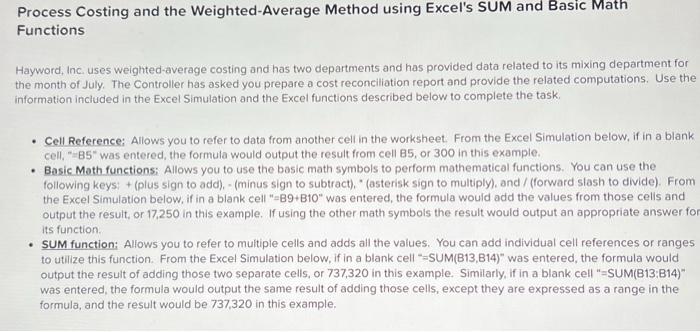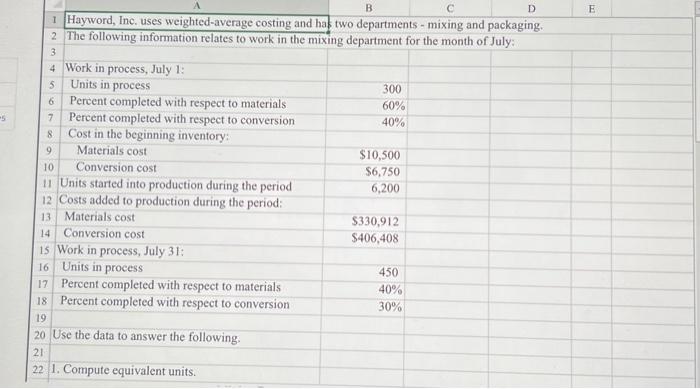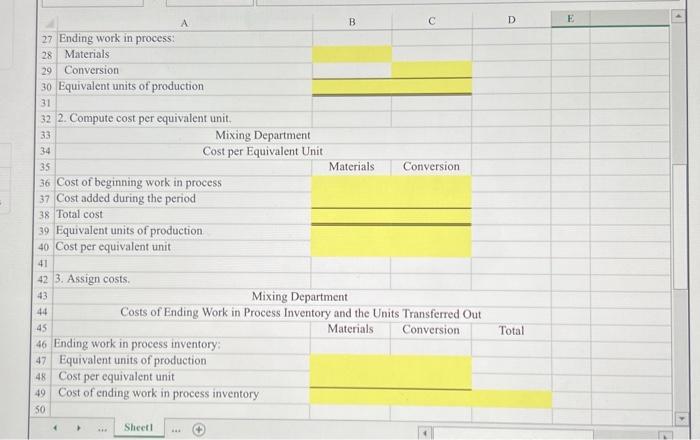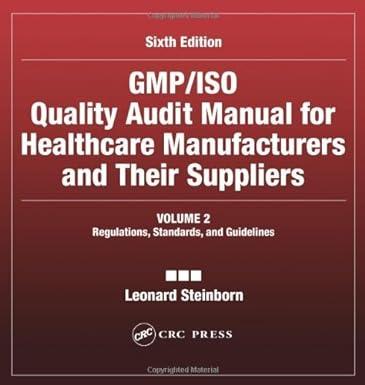Process Costing and the Weighted-Average Method using Excel's SUM and Basic Math Functions Hayword, Inc. uses weighted-average costing and has two departments and has provided data related to its mixing department for the month of July. The Controller has asked you prepare a cost reconciliation report and provide the related computations. Use the information included in the Excel Simulation and the Excel functions described below to complete the task. - Cell Reference: Allows you to refer to data from another cell in the worksheet. From the Excel Simulation below, if in a blank cell, "=85" was entered, the formula would output the result from cell B5, or 300 in this example. - Basic Moth functions; Allows you to use the basic math symbols to perform mathematical functions. You can use the following keysi + (plus sign to add), - (minus sign to subtract), " (asterisk sign to multiply), and / (forward slash to divide). From the Excel Simulation below, if in a blank cell "=B9+B10" was entered, the formula would add the values from those cells and output the result, or 17,250 in this example. If using the other math symbols the result would output an appropriate answer fo its function. - SUM function: Allows you to refer to multiple cells and adds all the values. You can add individual cell references or ranges to utilize this function. From the Excel Simulation below, if in a blank cell "=SUM(B13,B14)" was entered, the formula would output the result of adding those two separate cells, or 737,320 in this example. Similarly, if in a blank cell "=SUM(B13:B14)" was entered, the formula would output the same result of adding those cells, except they are expressed as a range in the formula, and the result would be 737,320 in this example. \begin{tabular}{|l|l|l|} \hline 49 & Cost of ending work in process inventory \\ 50 & \\ 51 & Units completed and transferred out: \\ 52 & Units transferred to the next department \\ 53 & Cost per equivalent unit \\ 54 & Cost of units transferred out \\ 55 & \\ 56 & 4. Prepare reconciliation. \\ 57 & Mixing Department \\ \hline 58 & Cost Reconciliation \\ 59 & Costs to be accounted for: \\ \hline 60 & Cost of beginning work in process inventory \\ \hline 61 & Costs added to production during the period \\ \hline 62 & Total cost to be accounted for \\ \hline 63 & Costs accounted for as follows: \\ \hline 64 & Cost of ending work in process inventory \\ \hline 65 & Cost of units transferred out \\ 66 & Total cost accounted for \\ \hline 57 & \\ \hline \end{tabular}










